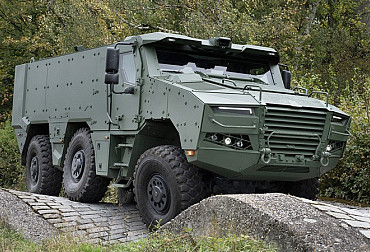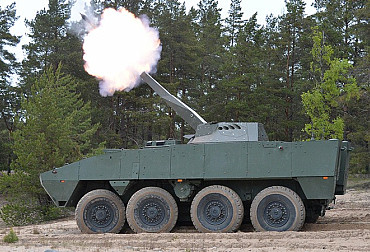Mobile Air Defense on the 8x8 platform and options for the Slovak Army
The use of new technologies in armed conflicts is increasingly common. The importance of drones and various Unmanned Aerial Vehicles is constantly growing, and the armies are introducing this type of technology into their arsenal across continents. However, the relatively easy and cheap availability of new technologies, such as attack drones and UAVs, poses a new threat to the armed forces and to the states themselves, especially if various non-state actors access such technologies. The importance of modern technologies and possible threats associated with them must also be perceived by the Slovak Army.
To begin with, it must be said that the Slovak Army still relies to a large extent on several decades-old military technology of Soviet production. This also applies to Air Defense systems. The Slovak Army uses the 2K12 Kub and S-300 PMU Air Defense systems and the 9K38 Igla portable anti-aircraft missiles. The White Paper on the Defense of the Slovak Republic from 2016 envisages the replacement of the 2K12 Kub systems. The previous management of the Ministry of Defense of the Slovak Republic, led by Petr Gajdoš, launched a project to purchase new 8x8 wheeled armored vehicles, while the 8x8 platform can also be used to expand the capabilities of Air Defense units. The Ministry of Defense of the Slovak Republic selected AFV 8x8 Vydra, in the development of which the Finnish company Patria participated. However, after the accession of Jaroslav Naď to the position of Minister of Defense after the 2020 elections, the project of 8x8 wheeled vehicles stopped due to various controversies, and the new management of the ministry is currently conducting market research for new tracked IFVs. However, the wheeled combat vehicle project should not end due to the need to modernize Air Defense systems.
IM-SHORAD system
In April this year, the 5th Battalion of the 4th US Army Artillery Regiment, deployed in Ansbach, Germany, was the first unit to receive the IM-SHORAD (Initial Maneuver Short-Range Air Defense) mobile short-range Air Defense system. The IM-SHORAD system is the result of a collaboration between General Dynamics Land Systems and Leonardo DRS. The prototype of this system was first presented in Washington in 2019 at the annual AUSA meeting and exhibition. The IM-SHORAD system is designed to be able to destroy helicopters, airplanes, surface-to-air missiles and Group 1, 2 and 3 drones to protect maneuvering units.
.jpg) Picture: In April of this year, the 5th Battalion of the 4th US Army Artillery Regiment, which is stationed in Ansbach, Germany, was the first unit to receive the IM-SHORAD (Initial Maneuver Short-Range Air Defense) mobile short-range Air Defense system | U.S. Army / CC BY-NC-ND
Picture: In April of this year, the 5th Battalion of the 4th US Army Artillery Regiment, which is stationed in Ansbach, Germany, was the first unit to receive the IM-SHORAD (Initial Maneuver Short-Range Air Defense) mobile short-range Air Defense system | U.S. Army / CC BY-NC-ND
To clarify, these groups of drones are based on categorization by U.S. military and can be found in U.S. military material entitled „U.S. Pat. Army Unmanned Aircraft Systems Roadmap 2010-2035“. There are a total of five groups of drones. As already mentioned, the IM-SHORAD system is capable of destroying first, second and third group drones. According to the US Army classification, the first group includes devices with a maximum take-off weight of less than 20 pounds (approximately 9 kilograms), reach speeds of less than 100 knots, and are designed to perform tasks at a maximum height of 1,200 feet (approximately 365.7 meters above the ground). The second group of drones is classified by weight from 21 to 55 pounds (approximately 9.5 to 25 kilograms), speeds below 250 knots and operates at low and medium altitudes (3500 feet - about 1066 meters above the ground). For the third group of Unmanned Aerial Vehicles, the weight is less than 1320 pounds (less than 600 kilograms), the speed does not exceed 250 knots and they operate at medium altitudes (less than 18,000 feet above sea level).
Back to the IM-SHORAD system. The basic platform chosen for the IM-SHORAD system is the Stryker A1 armored combat vehicle from General Dynamics Land Systems. The IM-SHORAD module, which is installed on Stryker A1 vehicles and is called RIwP (Reconfigurable Integrated-weapons Platform), was supplied by Leonardo DRS. The turret from Leonardo DRS is armed with a FIM-92 Stinger launch system with four ground-to-air missiles, two AGM-114L Longbow Hellfire guided missiles, XM914 30 mm automatic cannon, M240 machine gun caliber 7.62 mm, sensor systems with electro-optical and infrared cameras for targeting and situational awareness. In addition, the Stryker A1 is equipped with a self-foreign identification system (IFF) as well as a multi-purpose hemispherical radar. According to army-technology.com, IM-SHORAD also has electronic warfare tools to improve situational awareness capabilities. In the future, the US military is also considering the use of lasers to increase efficiency in the fight against air threats.
 Picture: The IM-SHORAD system (pictured) is capable of destroying first, second and third group unmanned aircraft U.S. Army / CC BY-NC-ND
Picture: The IM-SHORAD system (pictured) is capable of destroying first, second and third group unmanned aircraft U.S. Army / CC BY-NC-ND
Inspiration for Slovakia?
In the last few years, it has been possible to see several examples of the use of modern military technology, especially drones and UAVs in practice. We can mention, for example, the war in Nagorno-Karabakh, the attacks of the Yemeni Hutis (Ansar Allah) on the oil fields in Saudi Arabia, or the drone attacks on Russian positions in Syria. These and other examples should not escape the Slovak Army, which should consider how to face these threats in the future, because even commercial drones can be fitted with weapon systems or explosives. One of the ways in which Slovakia could prepare for this type of threat and at the same time revive the military Air Defense is the introduction of a system such as IM-SHORAD on the 8x8 platform. There are several reasons. One example is that the 2K12 Kub systems, as well as the future replacement of these systems, will serve primarily to defend strategic objectives and critical infrastructure, and not as army’s Air Defense. The 9K38 Igla are portable means, however, it is necessary to transport these systems to their destination and then bring them to combat readiness. The introduction of a similar system, such as IM-SHORAD, into the armament of the Slovak Army would eliminate the need to deploy the anti-aircraft missile system and the crew of the weapons could remain in its armored vehicle. There would be an army’s Air Defense that would directly protect the maneuvering units. An IM-SHORAD-like project may be one of the reasons to continue the acquisition of wheeled combat vehicles.
Source: army.mil, army-technology.com, leonardodrs.com, rosap.ntl.bts.gov, thedrive.com





















